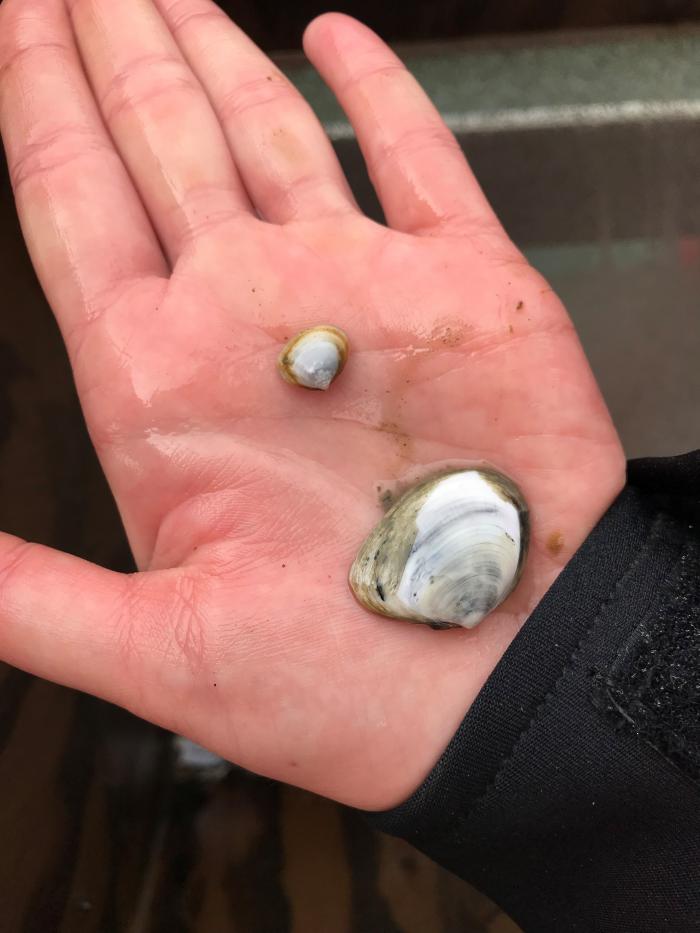We are continuing our expedition northward! Last night we passed through the Bering Strait and across the Arctic circle. We were able to see the Diomede Islands around 5am, a pair of islands that lie in the middle of the Bering Strait. These land formations are particularly interesting because the smaller of the two islands belongs to the United States and the larger one belongs to Russia. Little Diomede Island is about 2.8 square miles and, according to a 2010 census, has a population of about 110 people.
 A map of the location of the Diomede Islands in the Bering Strait.
A map of the location of the Diomede Islands in the Bering Strait.
In less than a week, the expedition has covered the DBO-1 line below St. Lawrence Island, the DBO-2 line northwest of Nome, and we will begin DBO-3 tonight. DBO stands for the Distributed Biological Observatory. These are designated areas, or stations, where benthic samples, water chemistry characteristics, and physical oceanography data are taken. Although research has been done in these places as far back as 30 years ago, Jackie Grebmeier and other collaborators have officially created a long-term data set since 2010. This means that Arctic researchers have been working together to collect their data in the same places each year to produce an assessment of the Arctic over time. This is a collaborative effort that will continue as climate change alters many aspects of the ecosystem. The DBO is a way for scientists to learn about how everyone's research fits together to paint a bigger picture of the Arctic processes as a whole.
 The Distributed Biological Observatory (DBO) sampling map.
The Distributed Biological Observatory (DBO) sampling map.
The DBO lines each show a different diversity of organisms. The benthic team has seen some very interesting invertebrates in the Van Veen grabs over the last week. Brittle stars in a variety of colors, from a light brown to pink, have shown up here and there. We even caught a Snow Crab in one of the grabs. The dominant clam species have been Macoma and Nuculana. Clams are particularly important because they are food sources for walrus, the Spectacled Eider, and others. They are both filter and deposit feeders meaning that they can get nutrients from filtering sea water or from dead organisms that are deposited in the mud.
 Piper Bartlett-Browne holds a brittle star.
Piper Bartlett-Browne holds a brittle star.
 Two species of the dominant clam Macoma.
Two species of the dominant clam Macoma.
 A Snow Crab is pulled from the Van Veen grab on the Healy.
A Snow Crab is pulled from the Van Veen grab on the Healy.
Ice Cream Cone worms, or Pectinaridae, are also deposit feeders that live in a calcium carbonate tube that looks like an ice cream cone. The larger opening of the cone is where the head of the organism is located and this is down in the mud with the tapered end sticking up. When they are taken our of their cone, they have beautiful golden "eyelashes" which they use to sift through the mud for food.
 An Ice Cream Cone worm in his tube.
An Ice Cream Cone worm in his tube.
DBO-3 will hold some of the same organisms for the benthic team as well as some new species that prefer the even colder waters of the Chukchi Sea. The sediment will also change from muddy to sandy to rocky, but that's a post for another day!
A Question From the Crow's Nest
What anatomical structure do predatory worms have to help them feed on prey?
Answer from previous post: A diurnal migration is a daily migration that animals such as plankton do. They move below the surface during the day and come up to the top of the water column at night.



Add new comment